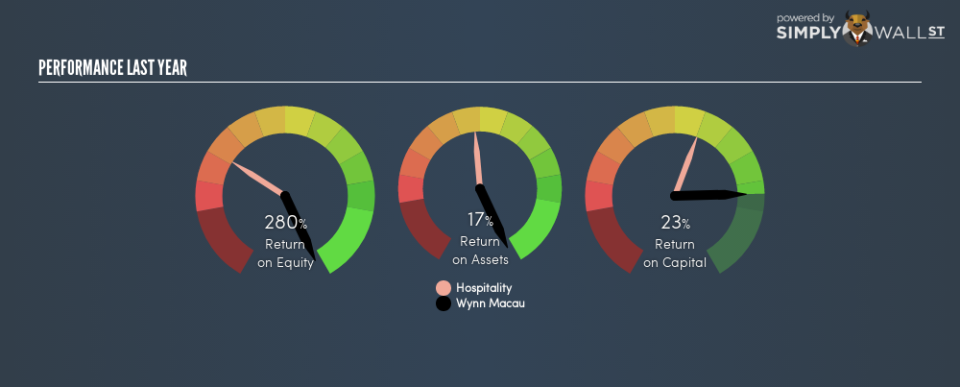Should You Like Wynn Macau, Limited’s (HKG:1128) High Return On Capital Employed?

Want to help shape the future of investing tools? Participate in a short research study and receive a 6-month subscription to the award winning Simply Wall St research tool (valued at $60)!
Today we are going to look at Wynn Macau, Limited (HKG:1128) to see whether it might be an attractive investment prospect. To be precise, we’ll consider its Return On Capital Employed (ROCE), as that will inform our view of the quality of the business.
First of all, we’ll work out how to calculate ROCE. Then we’ll compare its ROCE to similar companies. Finally, we’ll look at how its current liabilities affect its ROCE.
Return On Capital Employed (ROCE): What is it?
ROCE measures the ‘return’ (pre-tax profit) a company generates from capital employed in its business. Generally speaking a higher ROCE is better. Overall, it is a valuable metric that has its flaws. Renowned investment researcher Michael Mauboussin has suggested that a high ROCE can indicate that ‘one dollar invested in the company generates value of more than one dollar’.
How Do You Calculate Return On Capital Employed?
The formula for calculating the return on capital employed is:
Return on Capital Employed = Earnings Before Interest and Tax (EBIT) ÷ (Total Assets – Current Liabilities)
Or for Wynn Macau:
0.23 = US$704m ÷ (US$5.7b – US$1.4b) (Based on the trailing twelve months to September 2018.)
So, Wynn Macau has an ROCE of 23%.
View our latest analysis for Wynn Macau
Is Wynn Macau’s ROCE Good?
One way to assess ROCE is to compare similar companies. Wynn Macau’s ROCE appears to be substantially greater than the 5.2% average in the Hospitality industry. We consider this a positive sign, because it suggests it uses capital more efficiently than similar companies. Regardless of the industry comparison, in absolute terms, Wynn Macau’s ROCE currently appears to be excellent.
Our data shows that Wynn Macau currently has an ROCE of 23%, compared to its ROCE of 14% 3 years ago. This makes us think the business might be improving.
It is important to remember that ROCE shows past performance, and is not necessarily predictive. ROCE can be deceptive for cyclical businesses, as returns can look incredible in boom times, and terribly low in downturns. This is because ROCE only looks at one year, instead of considering returns across a whole cycle. Since the future is so important for investors, you should check out our free report on analyst forecasts for Wynn Macau.
What Are Current Liabilities, And How Do They Affect Wynn Macau’s ROCE?
Short term (or current) liabilities, are things like supplier invoices, overdrafts, or tax bills that need to be paid within 12 months. Due to the way ROCE is calculated, a high level of current liabilities makes a company look as though it has less capital employed, and thus can (sometimes unfairly) boost the ROCE. To counter this, investors can check if a company has high current liabilities relative to total assets.
Wynn Macau has total liabilities of US$1.4b and total assets of US$5.7b. As a result, its current liabilities are equal to approximately 24% of its total assets. The fairly low level of current liabilities won’t have much impact on the already great ROCE.
What We Can Learn From Wynn Macau’s ROCE
With low current liabilities and a high ROCE, Wynn Macau could be worthy of further investigation. You might be able to find a better buy than Wynn Macau. If you want a selection of possible winners, check out this free list of interesting companies that trade on a P/E below 20 (but have proven they can grow earnings).
For those who like to find winning investments this free list of growing companies with recent insider purchasing, could be just the ticket.
To help readers see past the short term volatility of the financial market, we aim to bring you a long-term focused research analysis purely driven by fundamental data. Note that our analysis does not factor in the latest price-sensitive company announcements.
The author is an independent contributor and at the time of publication had no position in the stocks mentioned. For errors that warrant correction please contact the editor at editorial-team@simplywallst.com.

